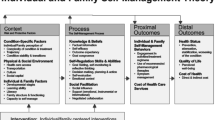Abstract
Professional organizations provide surveillance guidelines for BRCA1 and BRCA2 (BRCA) carriers with intact breasts and/or ovaries to facilitate early cancer detection. However, literature indicates adherence to surveillance guidelines is inconsistent at best. Using the Messaging Model for Health Communication Campaigns framework, we undertook a two-phase formative research approach to develop an intervention to promote adherence to surveillance guidelines. Discussion groups identified preferred intervention format and function in phase I. Findings indicated carriers desired a phone application (app) to assist with surveillance management and appointment tracking. Thus, an iPhone app for carriers to track appointments based on published surveillance guidelines was developed. In phase II, we obtained feedback from BRCA carriers via a survey during a prototype demonstration at a regional conference. Participants in phase II wanted reminder capabilities and the ability to add and modify information fields. This feedback informed intervention modifications, resulting in the Scheduling Necessary Advised Procedures (SNAP) iPhone app currently being pilot tested by BRCA carriers throughout the USA.


Similar content being viewed by others
References
Berliner, J., Fay, A., Cummings, S., Burnett, B., & Tillmanns, T. (2013). NSGC practice guideline: risk assessment and genetic counseling for hereditary breast and ovarian cancer. Journal of Genetic Counseling, 22(2), 155–163. https://doi.org/10.1007/s10897-012-9547-1
Botkin, J. R., Smith, K. R., Croyle, R. T., Baty, B. J., Wylie, J. E., Dutson, D., … McDonald, J. (2003). Genetic testing for a BRCA1 mutation: prophylactic surgery and screening behavior in women 2 years post testing. American Journal of Medical Genetics Part A, 118(3), 201–209.
Cohen, S. A., & McIlvried, D. E. (2012). Do BRCA1 and BRCA2 positive women need better follow-up? Gaining perspective from a Midwest population. Paper presented at the Poster presented at the Thirty First Annual Education Conference fo the National Society of Genetic Counselors, Boston.
Daly, M. B., Pilarski, R., Axilbund, J., Berry, M., Buys, S. S., Crawford, B., … Khan, S. (2016). Genetic/familial high-risk assessment. JNCCN Journal of the National Comprehensive Cancer Network, 14(2), 153–162.
Garcia, C., Wendt, J., Lyon, L., Jones, J., Littell, R. D., Armstrong, M. A., … Powell, C. B. (2014). Risk management options elected by women after testing positive for a BRCA mutation. Gynecologic Oncology, 132(2), 428–433.
Kuchenbaecker, K. B., Hopper, J. L., Barnes, D. R., et al. (2017). Risks of breast, ovarian, and contralateral breast cancer for BRCA1 and BRCA2 mutation carriers. JAMA, 317(23), 2402–2416. https://doi.org/10.1001/jama.2017.7112
Mattson, M., & Basu, A. (2010). Centers for disease control’s diethylstilbestrol update: a case for effective operationalization of messaging in social marketing practice. Health Promotion Practice, 11(4), 580–588.
Palmer, E. (1981). Shaping persuasive messages with formative research. In R. E. Rice & W. Paisley (Eds.), Public communication campaigns (pp. 227–238). Beverly Hills: Sage.
Peshkin, B. N., Schwartz, M. D., Isaacs, C., Hughes, C., Main, D., & Lerman, C. (2002). Utilization of breast cancer screening in a clinically based sample of women after BRCA1/2 testing. Cancer Epidemiology Biomarkers & Prevention, 11(10), 1115–1118.
Phillips, K. A., Jenkins, M. A., Lindeman, G. J., McLachlan, S. A., McKinley, J. M., Weideman, P. C., … Friedlander, M. L. (2006). Risk-reducing surgery, screening and chemoprevention practices of BRCA1 and BRCA2 mutation carriers: a prospective cohort study. Clinical Genetics, 70(3), 198–206.
Rothstein, M. A. (2016). Some lingering concerns about the precision medicine initiative. Journal of Law, Medicine and Ethics, 3(44), 520–525.
Schwartz, M. D., Kaufman, E., Peshkin, B. N., Isaacs, C., Hughes, C., DeMarco, T., … Lerman, C. (2003). Bilateral prophylactic oophorectomy and ovarian cancer screening following BRCA1/BRCA2 mutation testing. Journal of Clinical Oncology, 21(21), 4034–4041.
The Health Communication Capacity Collaborative. (n.d.). How to conduct qualitative formative research. Retrieved from http://www.thehealthcompass.org/how-to-guides/how-conduct-qualitative-formative-research.
Van den Akker, J. (1999). Principles and methods of development research. Design approaches and tools in education and training (pp. 1–14): Springer.
Funding
This study and portions of the development of the SNAP iPhone app were supported by funds from the National Society of Genetic Counseling Cancer Special Interest Group and from the St. Vincent Foundation.
Author information
Authors and Affiliations
Corresponding author
Ethics declarations
Conflict of Interest
Courtney Scherr, Jessica Feuston, Dawn Nixon, and Stephanie Cohen declare that they have no conflict of interest.
Human Studies and Informed Consent
All procedures followed were in accordance with the ethical standards of the responsible committee on human experimentation (institutional and national) and with the Helsinki Declaration of 1975, as revised in 2000. Informed consent was obtained from all patients for being included in the study.
Animal Studies
No animal studies were carried out by the authors for this article.
Rights and permissions
About this article
Cite this article
Scherr, C.L., Feuston, J.L., Nixon, D.M. et al. A Two-Phase Approach to Developing SNAP: an iPhone Application to Support Appointment Scheduling and Management for Women with a BRCA Mutation. J Genet Counsel 27, 439–445 (2018). https://doi.org/10.1007/s10897-018-0222-z
Received:
Accepted:
Published:
Issue Date:
DOI: https://doi.org/10.1007/s10897-018-0222-z




